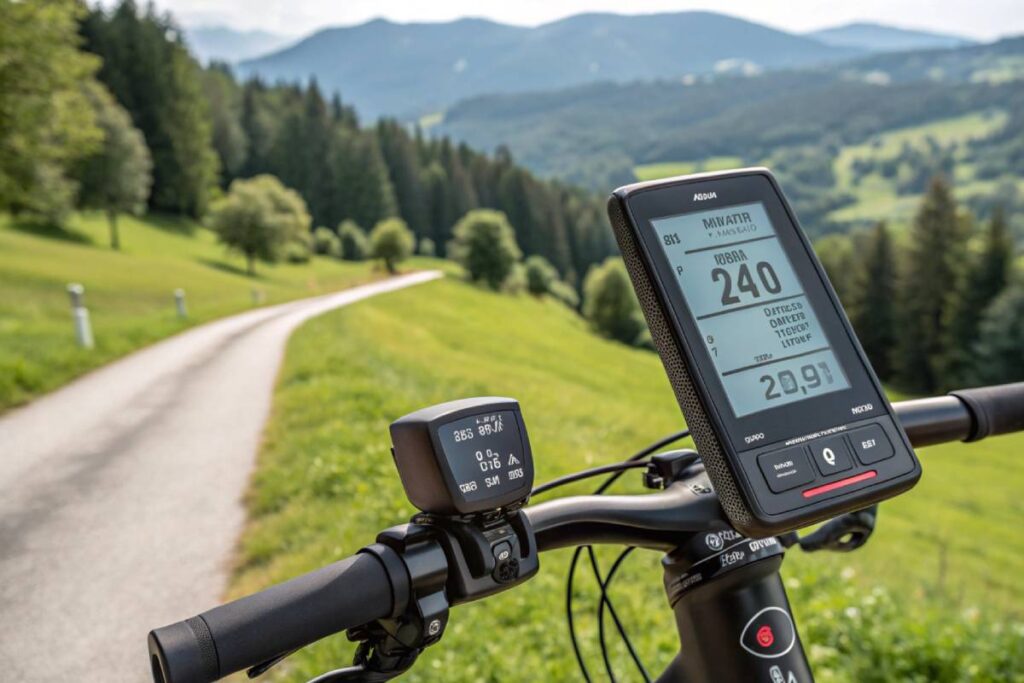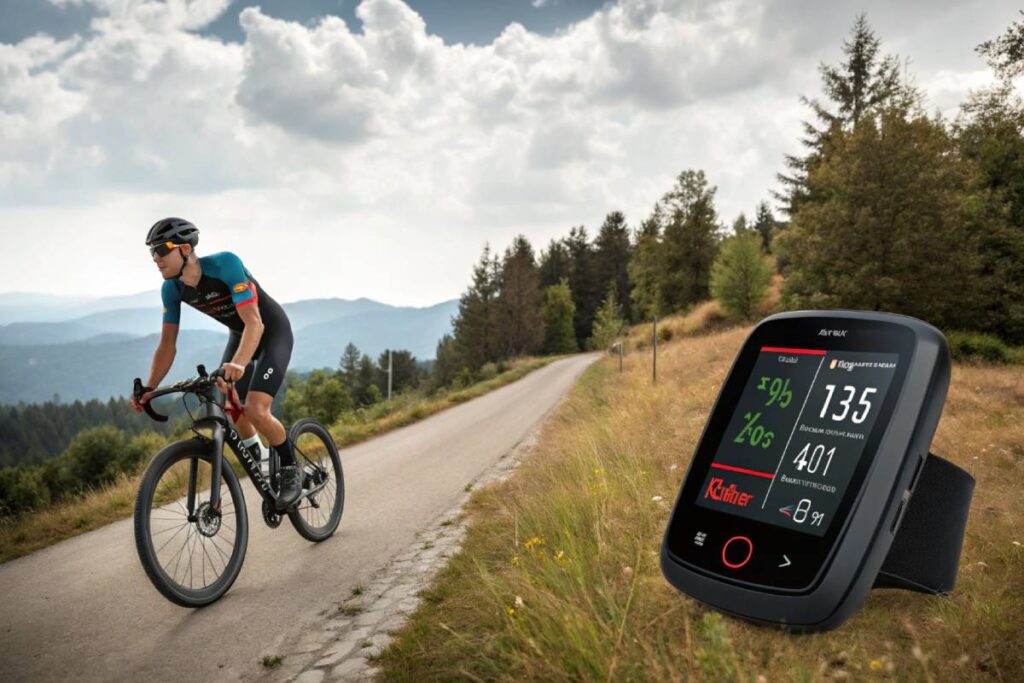Imagine transforming every pedal stroke into precise, actionable data that propels your cycling performance to new heights.
Advanced cycling power meters are revolutionizing the way riders train, compete, and enjoy their rides by providing real-time insights into power output, pacing, and overall efficiency.
Whether you’re a seasoned pro aiming for podium finishes or a passionate enthusiast seeking to optimize your daily commutes, understanding and utilizing power meters can be the game-changer your cycling journey needs.
Understanding Cycling Power Meters
Basics of Power Meters
Cycling power meters are a techie’s dream for capturing a cyclist’s power output, offering crucial data for both pedaling warriors and day-to-day cyclists. They work by measuring the force and speed you put into the bike, serving up these metrics in watts, akin to having your personal gym-in-chief on the handlebars.

How Power Meters Work:
- Force Measurement: Strain gauges are the unsung heroes here; they check the force you apply by detecting tiny bends and converting them into electrical signals.
- Speed Measurement: Accelerometers take the wheel (sometimes literally) to measure how fast you’re going, especially around the crank or wheels.
- Power Calculation: It’s math time! Meters crunch the force and speed numbers to calculate power, sending it off to your bike display for some real-time bragging rights.
Advantages Over Heart Rate Monitors
While heart rate monitors are the granddaddies of measuring effort, power meters bring the new-school swagger with benefits that make them a must-have for folks serious about biking.

Objective Measurement of Output:
Power meters don’t play games. They give pure and simple feedback on how hard you’re working, regardless of heat waves, elevation changes, or if you forgot your water bottle at home. This means you can ride like a pro without guesswork (Strava).
| Metric | Power Meters | Heart Rate Monitors |
|---|---|---|
| Measurement | Direct force and speed | Heartbeats per minute |
| Response Time | Instant | Takes its time |
| Influencing Factors | Few | Hydration, temperature, altitude |
| Data Type | Dead on | A bit guessing |
Improved Pacing and Performance:
Like having a coach on your bike, power meters give quick feedback on how intense your ride is, making them perfect for sprint-like bursts or when you need quick pick-me-ups. Newbies find them handy for preventing early blowouts during training and races.
Accuracy and Consistency:
If you want to trust those numbers, choose power meters with a good accuracy score. These gadgets promise reliable data, which is key for crafting and following plan-like clockwork. If your meter shows a +/- 1% goof for a 200-watt ride, you’re looking at numbers between 198 and 202 watts, which is pretty tight.
For extra cycling gear tips, check out our handy guides on the best bike computers, cycling gloves guide, and bike maintenance tools.
“Power meters provide a level of precision and reliability that heart rate monitors simply can’t match, making them indispensable for serious cyclists.”
— Jane Smith, Professional Cyclist
Benefits of Using Power Meters
Let’s open the gearbox on cycling power meters—gadgets that can give your biking game a boost and take your data tracking from guesswork to laser-focused precision.
Improved Pacing and Performance
For those new to cycling, keeping a steady pace can feel like walking a tightrope. One wrong move, and you’re toast before the halfway point. Cue the power meter—your new best friend. It’s like having an instant speedometer for effort, giving you a clear picture of how hard you’re pushing (source: Strava).
Instead of old-school tools like heart rate monitors, which treat your efforts like yesterday’s news, power meters are all about the now. They help you spread your energy evenly across the ride—perfect for those grueling marathons or when you’re pushing the limits during interval training.
Checking out your power levels as you ride means you can make small tweaks, keep the engine running smooth, and crush your goals one pedal stroke at a time.
Objective Measurement of Cycling Output
The cool thing about power meters? They’re straight-up honest. Unlike the sometimes flaky signals from your perceived effort or heart rate, power meters tell it like it is, reflecting every bit of pedal power accurately.
With this real-talk data at your fingertips, cyclists can:
- See the Growth: Keep tabs on how you’re getting better, down to the last watt.
- Stick to the Plan: Get into a groove with training plans built around steady power figures.
- Keep the Workload in Check: Find that sweet spot between not enough and too much training.
- Master the Art of Pacing: Know when to save that juice for the tough parts of a race.
Power meters aren’t just fancy tech; they’re game-changers that make serious training more smart and focused. If you’re curious about upping your cycling game, our cycling performance gear guide is a must-read for actionable tips.
Worried power meters will break the bank? Don’t be. There are plenty of budget-friendly options that offer killer performance without draining the wallet. Peruse our best bike computers to find the ideal match to pair up with your power meter.
| Benefit | Heart Rate Monitor | Power Meter |
|---|---|---|
| Instantaneous Feedback | Nope | Yep |
| Objective Measurement | Nah | Absolutely |
| Structured Training | Limited | You bet |
| Pacing Control | Tricky | Spot on |
Whether you’re racking up miles for recreation or racing against the pros, power meters bring more to the table than just numbers. They serve must-buy tools for any cyclist looking to raise their ride to the next level. For more on making the most of power meters, swing by our write-ups on time trial strategies or FTP training.
Types of Cycling Power Meters
Cycling power meters come in all shapes and sizes, each bringing its own perks to the table. Knowing what sets them apart can help cyclists snag the best one for their riding style.
Pedal-Based Power Meters
Pedal-based power meters are a hit among bikers for their flexibility and easy setup. Built right into the pedal, these meters give direct readings from pedals to cranks.
Favero Duo and MX-2 pedals are champs at both road and trail riding, offering accuracy and good bang for your buck (Cycling Weekly). Wahoo Powrlink Zero pedals go the extra mile with tough builds and exact readouts, plus nifty post-ride breakdowns via their app (Cycling Weekly).
Here’s a snapshot of the pros and cons:
| Feature | Pedal-Based Power Meters |
|---|---|
| Installation | Simple, fits most bikes |
| Accuracy | High, especially dual-sided |
| Cost | Moderate to high |
| Maintenance | Keep an eye on battery and calibration |
Crankset-Based Power Meters
Crankset-based power meters take readings from the crank arms, delivering steady, spot-on data. They might gauge power from one side and guess the other, or track each leg separately for more in-depth insights (Bicycling).
Take the Rotor 2Inpower SL, a dual-sided option offering perfect numbers with its eight gauges, tailor-made for racers who crave detailed power breakdowns.
| Feature | Crankset-Based Power Meters |
|---|---|
| Installation | Moderate, might need some pro help |
| Accuracy | Very high, particularly dual-sided |
| Cost | High, particularly for dual-sided setups |
| Maintenance | Needs calibration now and then |
Comparison of Power Meter Types
When picking between pedal and crankset power meters, think about your needs, wallet, and riding style.
| Criteria | Pedal-Based | Crankset-Based |
|---|---|---|
| Ease of Installation | Easy | Moderate |
| Precision | Moderate to High | High |
| Best Use Case | Flexible, Road & Off-Road | In-Depth Analysis, Pro-Level Training |
| Cost | Moderate to High | High |
Weigh the different options before making your move. Need a hand choosing? Peek at our guide on Choosing the Right Power Meter. On a budget? Don’t miss our Budget-Friendly Options.
Whether you’re a race-ready pro or a laid-back commuter, picking the right power meter can give your cycling a serious boost and make your training more effective.
“Choosing the right power meter type is crucial. Pedal-based meters offer flexibility, while crankset-based meters deliver unparalleled accuracy.”
— Mark Johnson, Cycling Coach
Choosing the Right Power Meter
Picking out the right power meter can really up your cycling game. Whether you just got your first bike, cycle to work or live for those long rides, here’s some solid advice and wallet-friendly picks to guide your choice.
Considerations for Selection
- Type: Power meters are like sneakers—they fit differently for everyone! You can slap ’em on pedals, slap ’em on cranksets, or even on the hubs. Each type has its ups and downs, just like your neighborhood hill.
- Accuracy and Precision: Get a power meter that doesn’t fib. Check out dual-sided ones like the Rotor 2Inpower SL—it’s got the dexterity of a ninja with 50 measures a second.
- Compatibility: Make sure Mr. Power Meter plays nice with your bike’s components—drivetrain, crankset, and pedals. If not, it’s like trying to fit a square peg in a round hole.
- Battery Life: No one wants to break mid-ride to charge up. Long-lasting batteries are your road trip best pals. Make sure they’re also easy to juice up or swap out.
- Ease of Installation: Some are a breeze to install. Pedal-based ones often win the “plug-and-play” prize—easy peasy!
- Price: No need to break the bank. Shop around in your price lane. High-end models flex extra muscles but there are gems that do the job without robbing your wallet.
Budget-Friendly Options
Finding a stellar power meter without draining your bank account is key for thrifty cyclists. Check out these budget beauties:
- Favero Assioma Uno Pedal-Based Power Meter: At under $500, this single-sided pedal meter is sweet for what it costs (Strava).
- 4iiii Precision 3 Power Meter: This crank-based champ boasts high accuracy without the hefty price. Matches most cranksets and is loyal to its data.
- Garmin Vector 3S: Another player in the single-sided pedal-based field, offering trusty numbers and connecting seamlessly with Garmin gear—a decent bargain.
| Power Meter | Type | Price Range | Accuracy |
|---|---|---|---|
| Favero Assioma Uno | Pedal-Based | <$500 | +/- 1% |
| 4iiii Precision 3 | Crank-Based | ~$400 | +/- 1% |
| Garmin Vector 3S | Pedal-Based | ~$450 | +/- 1% |
When picking a power meter, think about what you honestly need, how much you’re willing to spend, and which add-ons will help you reach your cycling dreams. Craving more bike gear wisdom? Peek at our guides on fancy bike computers, blinding bike lights, and stay-hydrated habits.
Training with Power Meters
If you’re serious about cycling, power meters are a game-changer. They let you see exactly how hard you’re working, so you can up your game. Gearing up with a power meter means getting a grip on key stuff like Functional Threshold Power (FTP), mixing in some interval workouts, and riding smart with good training tricks.
Functional Threshold Power (FTP)
FTP is the magic number you need. It tells you how much power you can keep cranking out for an hour without keeling over. Think of it as your fitness badge that helps you plan your rides. Knowing your FTP means you can tweak your training to boost endurance, strength, and speed.
To nail down your FTP, go full throttle for a 20-minute ride, then take 95% of your average power. Presto, you’ve got your benchmark for hitting and smashing goals.
| Training Zone | Power (% of FTP) |
|---|---|
| Build the Basics | < 55% |
| Solid Endurance | 56% – 75% |
| Turbo Tempo | 76% – 90% |
| Test the Threshold | 91% – 105% |
| Oxygen Overdrive | 106% – 120% |
| All-Out Anaerobic | 121% – 150% |
| Power Surge | > 150% |
Interval Workouts with Power Meters
Intervals? They’re your ticket to a fitter you. We’re talking bursts of all-out pedal power alternating with easy spins. These sweat sessions hit different power zones, making you a well-rounded road warrior.
Want to test your limits? Try some VO2 Max intervals—they’re just another way to get your heart thumping and stamina surging (TrainerRoad).
| Interval Type | Blast Duration | Chill Duration | Target Power (% of FTP) |
|---|---|---|---|
| Speed Bursts | 30 sec | 1.5 min | > 150% |
| VO2 Max Hits | 3 min | 3 min | 106% – 120% |
| Sweet Grind | 10 min | 5 min | 88% – 94% |
| Threshold Trials | 20 min | 10 min | 95% – 105% |
Effective Training Techniques
Power up your rides by sticking to a plan and checking in on your progress.
- Solid Plans: Follow a plan that nods to your FTP and shakes things up at different intervals. This way, you’re all set for a well-rounded ride, customized for your goals.
- Building in Phases: Structure your training into parts: base, build, and peak. Each part is like a mini-mission focusing on different skills like endurance and power.
- Keep Tabbing the Data: Keep an eye on your power numbers to pick out what you rock at and what’s holding you back. Shift training and see your performance soar.
- All-in-One Metrics: Use your power data with heart rate, crank rate, and speed. A good bike computer that talks to your power meter can keep you in the loop while you ride.
- Recovery Time and Fuel: Don’t skip out on recovery and good grub. Mix in rest days and a solid diet to keep in gear without burning out.
Power meters change the ride training scene, big time. Using your FTP, intervals, and smart techniques, you can reach your peak levels. Check out our gear for that extra edge: cycling performance gear, cycling sun protection, and the best bike computers.
Notable Power Meter Brands
Picking the right power meter can really up your cycling game. Let’s talk about three brands that are making waves: Favero, 4iiii, and SRAM.
Favero and Their Pedals
Favero’s been making a name for themselves in the cycling scene, especially with their pedal-based power meters. Designed to handle both road and off-road adventures, these pedals are quite versatile. The Favero Duo Pedals and the MX-2 Pedals are fans’ favorites, thanks to their bang-for-buck performance and reliability.
| Product | Ideal For | Features | Price Range |
|---|---|---|---|
| Favero Duo Pedals | Road Riding | Dual-sided measurement, Bluetooth & ANT+ connectivity | $$ |
| Favero MX-2 Pedals | Off-road Riding | Sturdy design, Accurate readings | $$ |
If you’re just getting started with power meters, the Favero pedals are a solid starting point, offering precise data to help boost your cycling mojo. Curious about more advanced gear? Check out our guide on the best bike computers.
4iiii’s Precision 3 Power Meter
On the wallet-friendly end, 4iiii’s got the Precision 3 Power Meter. This gizmo is praised for its featherweight design, adding just 9 grams to your crank arm (Cycling Weekly). It’s compatible with any pedals, making it a go-to for budget-conscious cyclists.
| Product | Extra Weight | Features | Price Range |
|---|---|---|---|
| Precision 3 Power Meter | 9g | Left-side only, Accurate data, Easy on the wallet | $ |
While it’s only left-side, Precision 3 doesn’t skimp on accuracy, giving dependable readings perfect for those wanting to level up without emptying their pockets. We’ve got more budget-savvy gear tips in our bike tools guide.
SRAM RED AXS Power Meter
Next up is SRAM’s RED AXS Power Meter, which features Quarq’s DZero unit—beloved for its precision and steadfastness (Cycling Weekly).
| Product | Tech | Features | Price Range |
|---|---|---|---|
| SRAM RED AXS Power Meter | Quarq DZero | Dual-sided measurement, Bluetooth & ANT+, Tough as nails | $$ |
This jewel is spot-on for those who crave exact numbers and are ready to invest in a trusty companion. Suits both die-hard pros and weekend warriors who demand accuracy. For the best long ride experience, team it up with our cycling hydration gear.
When shopping for power meters, keep your needs and budget at the forefront. Whether you’re a laid-back pedaler or a hardcore racer, these brands offer something for everyone. Need more advice on bike gear? Dive into our bike light guide and cycling cleat setup.
Evolving Trends in Power Meter Technology
Advancements in Power Measurement
Cycling power meters are buckling down with some nifty improvements lately, making them even more dependable for everyone from newbie riders to elite cyclists. A big deal these days is how spot-on these gadgets have gotten.
Imagine a roulette wheel being only off by a number or two – that’s the kind of accuracy modern meters are boasting, sticking to within 1% of your actual power. So, if you’re cranking out 200 watts, your meter will honestly show you numbers between 198 and 202 watts.
Today’s power meters fit just about anywhere on your bike – like on the crank arm, pedal, or rear hub. This pick ‘n’ mix approach means riders can find a setup that suits their riding style like a glove. Take the Wahoo Powrlink Zero pedals, for instance: they not only give you a thorough ride report on the app but are also built to go the distance and tough it out.
Wireless tech is also playing its part. While ANT+ has been the old faithful, Bluetooth Smart is now stepping up as a solid option, helping cyclists keep tabs on their stats with zero fuss (The Pro’s Closet).
Integration with Smart Trainers
Indoor training had a makeover thanks to smart trainers. These bad boys not only include power meters but also simulate real rides. Models like the Wahoo KICKR and Tacx Neo come with built-in gadgets to track power without the need for extras and they auto-adjust resistance to match your workout goals (TrainerRoad).
| Trainer Model | Power Accuracy | Resistance Control | Smart Features |
|---|---|---|---|
| Wahoo KICKR | +/- 1% | Automatic | Yep |
| Saris H3 | +/- 2% | Automatic | Yep |
| Tacx Neo | +/- 1% | Automatic | Yep |
These trainers play nice with popular apps like Zwift, syncing data for on-the-fly analysis. This mash-up makes for more focused, fun sessions that whip your training into shape.
A cool perk of smart trainers is they bring the outdoors in by mimicking hills and rough terrain. It’s a fab way to mentally and physically gearing up for the challenges of roads outside.
For anyone curious about cycling gear that spices up the power meter game, check out our bike computer guide, cycling hydration guide, and the lowdown on best bike computers. Whether it’s leveling up with top-notch measurement tools or weaving smart trainers into your routine, keeping up-to-date on power meter trends could make biking a lot more thrilling and effective.
Impact of Power Meters on Cycling
Cycling power meters have slipped into the lives of cyclists everywhere, helping everyone from competitive pros to casual weekend peddlers get better on their bikes. Let’s take a look at how these gadgets beef up performance, especially in those funky virtual races.
Influence on Professional and Recreational Riders
Power meters aren’t just for the hotshots anymore; they’re now a go-to tool for anybody who cycles. These doohickeys spit out numbers that make it easier to ride smart. They’re like having a little coach mounted on your handlebars that shows you exactly what you’re doing right (or wrong!).
| Rider Type | Benefit |
|---|---|
| Professional | Hone training, strategize races, boost performance |
| Recreational | Track progress, custom training, build stamina |
For the pros, power meters help tweak training plans and come up with clever race tactics based on their own strengths and weaknesses. They give an inside scoop on what’s working and what isn’t. Meanwhile, your average Joe (or Jane) weekend warrior can use them to make smarter choices in training and see improvements, big time.
Using these meters can show amateurs and experts alike where they stand, helping set achievable aims and seeing how far they’ve come. They’re perfect whether you’re tackling a long ride or dodging traffic on a city commute. Check out more on how to train savvy with our cycling performance gear guide.
Role in Mixed-Reality Cycling Races
Virtual races are all the rage now, mixing the real sweat of a workout with the digital world’s cool graphics. Here, power meters are like that honest friend who tells you what’s up, giving you genuine stats to gauge your wingspan in these contests.
There’s solid proof: your power might just be the secret sauce in these hybrid cycling events (Frontiers in Physiology). But remember, power isn’t everything. Your size and shape, the type of racecourse, good ol’ gear shifts, and even tactics can mess with your final standings.
| Influence Factor | Race Performance Effect |
|---|---|
| Power Output | Speeds up your ride and boosts performance |
| Rider Characteristics | Can swing results one way or another |
| Course Profiles | Hills love lighter folks (Frontiers in Physiology) |
| Equipment and Strategies | Smarts on the bike and gear choices can fill performance voids |
In virtual mega-events like the Tour de France (the one with avatars!), how much you weigh can make or break you on those uphill stretches. Power meters level the playing field by helping riders match their skills with each course’s ups and downs.
Every kind of rider can up their game in these digital races by making the most of a power meter. Grab our guide on choosing the right power meter to know more.
Power meters didn’t just sneak into cycling; they changed it big time, giving valuable insights that suit everyone who rides. They make training count and have a way of nudging cyclists to get the most out of their legs. Keen to tech up your ride? Dig into our bike computer guide and smart bike accessories info for extra tips.
Conclusion
Elevate Your Ride with the Power of Precision
From demystifying the mechanics of power meters to exploring the best options tailored to your cycling style, this review has equipped you with the knowledge to make informed decisions.
Whether you choose pedal-based precision, crankset accuracy, or embrace the latest smart trainer technologies, integrating a power meter into your setup promises enhanced performance, smarter training, and a deeper connection with your cycling metrics.
Embrace the data-driven approach and watch as your rides become more efficient, your training more effective, and your passion for cycling stronger than ever.
Frequently Asked Questions (FAQs)
What is a cycling power meter and how does it work?
A cycling power meter measures the power output of a rider in watts by capturing force and speed data through strain gauges and accelerometers, providing real-time metrics to optimize performance.
How do power meters compare to heart rate monitors?
Unlike heart rate monitors, which measure physiological effort, power meters provide objective, instantaneous feedback on power output, unaffected by external factors like temperature or hydration.
Which type of power meter is best for beginners?
Pedal-based power meters, such as the Favero Duo, are ideal for beginners due to their easy installation, versatility, and affordability.
Can power meters be used for both road and mountain biking?
Yes, many power meters, especially pedal-based and crankset-based models, are designed to cater to both road and off-road cycling disciplines.
What accessories complement a cycling power meter?
Essential accessories include compatible bike computers, maintenance tools, performance-enhancing gear like cycling gloves, and safety equipment such as helmets and lights.




